In My Backyard: Year 10
Apart from a few deep thoughts we strung together for your consideration three and six weeks ago, dearest readers, it has been a long while since we officially addressed the residents of our Champaign-Urbana backyard, the same one in which we work a lot, play some, dream a little, and sporadically fizzle out when no one is looking. Although we last drafted a full “In My Backyard” from scratch back in 2012, there is probably not much use in forcing a massive MFHQ brain dump in 2017 so we can retro-write the missing annual summaries. Just the same, you are more than capable of reviewing C-U Blogfidential at any time for the names, titles, dates, and stories you need to know about our shared cinema culture. Consider this post a creative placeholder that gives us an excuse to revive old and obscure copy from various sources, flesh out past moments in the Confidential history, and lead us numerically towards a brand-new “Year 12” entry with our 11th anniversary in the books as of last Saturday, February 25. Much of this material will appear on CUBlog for the first time, providing alternate takes on certain topics du C-U.
In this third lap ‘round the “Backyard,” we consider what it means to reinvigorate old social movements and their ideals. Your humble editor remembers a time frame preceding the launch of this Web site when he was uncertain of a direction, especially with employment at The Octopus taken away from him and MICRO-FILM duties on the wane. An early component of the Urbana-Champaign Independent Media Center, the in-house Production Group, held a key place for him in this era. Bright minds met on weeknights in downtown Urbana, alternating between the IMC space on the 200 block of W. Main St. and Embassy Tavern at 114 S. Race St., to cook up projects along with chewing over current news headlines and technology developments. Although this iteration managed not much apart from a few short citizen-journalist videos and activist film shows, it served as an eye-opening primer spent with individuals who are now highly accomplished in fields of communications, education, and computer sciences. Ye Ed does wonder if Paul, Colleen, Drew, Nikki, davep, and the rest will ever plot again.
With our media avengers disassembled and the Embassy long closed, the IMC itself has marched on through the proverbial thick and thin since being established in 2000, the year after progressive centers began cropping up across the United States in solidarity with coordinated efforts to counter the World Trade Organization conference held in Seattle. It has formally occupied for the last decade much of the Urbana Post Office building at 202 S. Broadway Ave., two blocks from its original storefront, and current leaders have been actively fulfilling its original promise as a highly diversified community center. Long-standing facets remain such as the Books to Prisoners program, Makerspace Urbana collective, WRFU-FM radio station, and Zine Library archive, while recurring and one-off events bring vitality under the “big tent” per incoming program director Brian Dolinar. They include popular education (#PopEd) sessions, “Open Scene” youth activities primarily funded by the National Endowment for the Arts (NEA), various social justice workshops, and showcases for political, ethnic, and alternative arts.
A cultural hub like the IMC is powered by its people above all else, but it always reaps the benefits of volunteer energies and supplemental funding. Outside planners can stage special events on the ample IMC main floor, affiliate groups might host regular meetings during the quieter hours, and hands-on creators may rent available rooms or nooks for studio space. As well, experts in our university community should consider venturing off campus to the IMC and teach the underserved of Champaign-Urbana all manner of skills to help them improve their lives and neighborhoods. Here is where we circle back to the Production Group. Does it exist in 2017? If not, would anyone take up that baton? The last time Ye Ed toured the main offices at the IMC, camera equipment and computer editing stations awaited use from those without the means to acquire their own gear. An arguable flaw of our old team, apart from the overall lack of output, was our concentration on creating and choosing media we thought worthwhile for others to see and not better engaging an audience in learning how to seek and produce on their own.
Contributed by yours truly to the Public i, an IMC publication now in its seventeenth year and found across the C-U, our highlighted treatise makes the case that accessible showcases fueled by non-mainstream material can only help to open minds as well as encourage the industrious to add their voices to the video mix. Centered on impressions gleaned from the second IMC Film Festival in Urbana and the first New Art Film Festival in Champaign, both held in 2010, its overall viewpoints and suggestions still apply today. It is worth noting the lack of a fully-equipped public studio for citizens in our twin cities – say, the media equivalent of the University of Illinois’ Community Fab Lab (fabrication laboratory) for dimensional design – although the outlets mentioned at the end of our reprint, along with the UI Media Commons for enrolled students that did not exist when the article first ran, still provide valid starting points for those who wish to try their hand at it. We believe that grassroots efforts with socially relevant views, no matter how low budget or rough, deserve to exist and can serve an audience at the IMC or elsewhere.
With that espoused, it’s time to read on, MacDuff…
~ Jason Pankoke
~~~~~
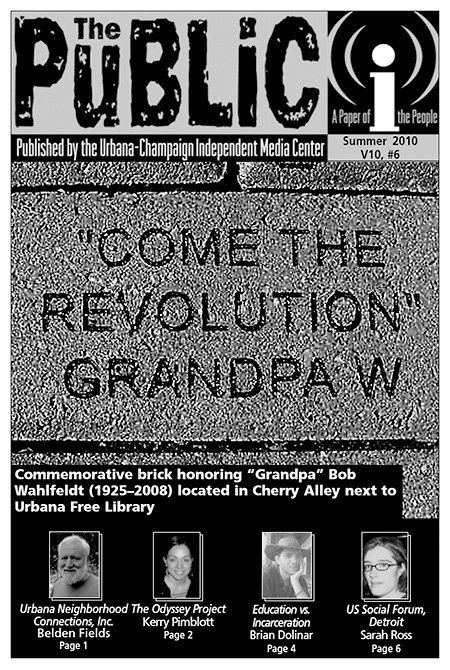
~~~~~
“Message and Medium Both Matter with Local Film Fests”
Between the Independent Media Center and Art Theater, hundreds of citizens took in films not ubiquitous thanks to the Hollywood marketing machine
by Jason Pankoke
For decades, Champaign-Urbana has inspired a long succession of independently-made media created by citizens, academics, and students wishing to enrich and inform their friends and neighbors in ways avoided by commercial outlets. This has encompassed print, radio, theater, music, the Internet, and the fine arts. However, the most ill-used form of modern communication to disseminate viewpoints and expression from a local perspective is arguably the one falsely believed to be the province of studio impresarios and celebrity egos―the cinema and its domestic offspring, television.
Consumer-priced technology improved and expanded so rapidly through the Nineties and into the new century that the videographer has found him- or herself with plenty of effective production tools and work flow options to aid in shooting and editing quality footage without the time and cost concerns associated with traditional film production. Should the videographer be in the right place at the right time with the competence to tape cleanly and confidence to stand their ground while doing so, she or he may come away with material that not only preserves our community’s history―warts and all―but shows by example how to improve its future as well.
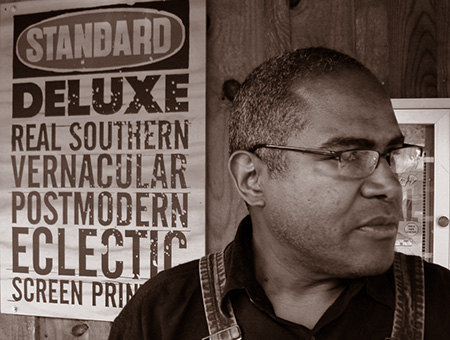
A recent example, however inadvertent, is John O’Connor’s recording of Champaign mayor Jerry Schweighart’s “Barack Obama is not an American” comment made at the city’s West Side Park. We should also recall the “Citizens Watch” videos made by Patrick Thompson and Martel Miller, depicting suspect interaction between C-U police officers and African-American residents. Certainly, we’ll mention the progressive work of UI journalism professor Jay Rosenstein, including the upcoming documentary about the landmark Vashti McCollum court case, THE LORD IS NOT ON TRIAL HERE TODAY. It’s unfortunate that the canon made autonomously in the area―excluding work produced expressly for commercial, institutional, or network television use―is often difficult to find save for collections at the IMC, That’s Rentertainment, public libraries, and so on.
By the same token, the flexibility allowed by today’s low-cost digital tools has ushered in a worldwide deluge of video material. How does one navigate through the noise to find worthwhile material regardless of where it was created, whom it was made by, or what it is about? Although one-off screenings of topical and ethnic material are presented on a regular basis by University of Illinois departments and local organizations like A.W.A.R.E., the Illinois Disciples Foundation, the University YMCA, and the IMC, it is rare to witness aggregate presentations of alternative cinema lasting two or more consecutive days. The most substantial of recent vintage, the Freaky Film Festival from 1997-2000, has finally been succeeded in spirit by two events which have taken place this year.
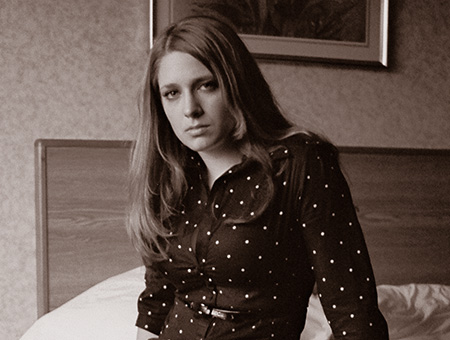
The IMC Film Festival, a three-day showcase held at the Independent Media Center in Urbana during the first weekend of February, and the New Art Film Festival, which ran for six days in mid-April at the Art Theater in Champaign, provided opportunities to watch hand-picked indie films running the gamut of documentary, narrative, and experimental story-telling, with many projects developed and/or produced right in our own backyard. As a volunteer to the former and a programmer of the latter, I can describe the character of each as “eclectically distinct” from the other although value and inspiration could be drawn from both.
Following up its first edition from a year prior, the IMC Film Fest provided our community with a diverse showcase that enlightened its audience. Some blocks tied into different aspects of the IMC such as opening pieces CLOWNIN’ KABUL by Enzo Balestrieri and Stefano Moser and SALUD by Connie Field, presented by the Gesundheit! Institute, and closing material shown in concert with a People’s Potluck including videos by Chicago Indy Media about Fred Hampton, Jr., and G20 protests as well as UN POQUITO DE TANTA VERDAD by Jill Friedberg, recounting the people of Oaxaca, Mexico, who reclaimed local radio stations. Other blocks demonstrated a myriad of personal perspectives, such as the dramatic shorts CELESTE ABOVE by Johnny Robinson and AS EVER, STAN by Alex Schwarm, the energetic political graffiti documentary A SERIES OF EXCHANGES by Justin Jach, and non-narrative landscape works like ROSWELL by Bill Brown and THE BAY SWIMMERS by Jesse Damazo.
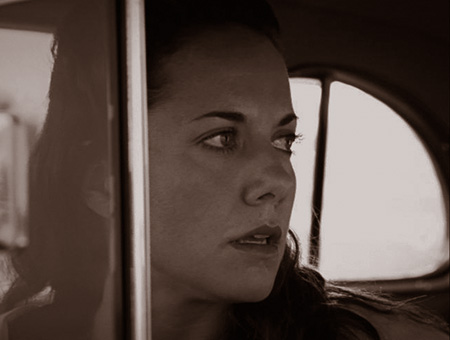
IMCFF also grew to include special showings and satellite events which engaged the audience beyond the silver screen. For instance, the first night concluded with a broadcast of WRFU’s “The Show” in the stage area featuring monologues by host Ray Morales, slam poetry, and freestyle rhyme with live percussion. The second night’s film highlights included a live multi-instrumental performance of an original score composed by UI graduate student Vin Calianno in synch with the silent German classic, THE CABINET OF DR. CALIGARI, followed by a multi-media performance comprised of found footage projected by Matt HarsH and choice cuts played by DJ Belly.
While programming overlap could be found between IMCFF and the New Art Film Festival, it simply expanded the amount of exposure given to locally-made films. The six-day schedule allowed NAFF room to reprise movies that have already been shown publicly, including the features ACT YOUR AGE (IMCFF ’10) and PRESS START and the shorts PRELUDE and THE TRANSIENT (both IMCFF ’09), as well as titles playing for the first time in C-U. These included the documentary HOOPESTON, a portrait of the town and its former “Witch School,” the twisty thriller A CERTAIN POINT OF VIEW, filmed on the University of Illinois campus, and the low-key feature drama THE SCIENTIST, self-distributed by Carbondale director Zach LeBeau. NAFF also brought back a hit from last year’s IMCFF, the artist documentary PROCEED AND BE BOLD! directed by UI alumna Laura Zinger, for all the positive lessons it embodies in regards to self-expression, self-determination, and DIY ethos.
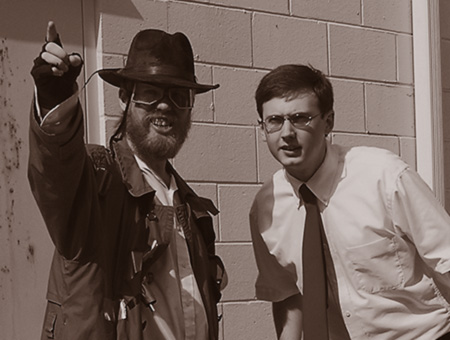
Between IMCFF and NAFF, hundreds of fellow citizens took in dozens of films not already ubiquitous thanks to the Hollywood marketing machine. The programming decisions were also not influenced overtly by C-U’s own populist movie phenomenon, Roger Ebert’s Film Festival. Passion and intelligence guided the two core teams – Nicole Pion [Lanoue], Katy Vizdal, Brian Dolinar, Laura Fuhrman, and yours truly for IMCFF, and myself and Sanford Hess for NAFF – to formulate what would make for good cinema viewing and great food for thought.
Of course we now ask, “What locally-produced films will we see at these events next year?” Take up your camera in arms and then take advantage of several potential resources – including the IMC, Urbana Public Television, Champaign Government Television, UI-7, Parkland College Television, and the monthly Champaign Movie Makers meetings at Class Act Interactive – to enhance your skills and meet fellow citizens with whom you can collaborate. You can also keep tabs on local activity and viewing opportunities at C-U Blogfidential. Until then, we can’t wait to hear you yell, “Action!”
~~~~~
“Message and Medium Both Matter with Local Film Fests”
originally appeared in
Public i, Vol. 10, No. 6, Summer 2010, p.7.
Article © Jason Pankoke. Used with permission.
CUBlog edits © 2017 Jason Pankoke
Graphics © their respective owners.
From the collection of the author.
~~~~~
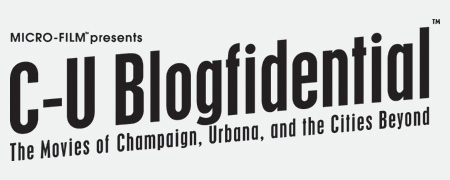
C-U Blogfidential: Year 9*
Posts: 123 ~ ** ~ Interviews: 2 ~ Articles: 8*** ~ Almanacs: 5
Columns: 1 ~ Reviews: 0 ~ Publications: 0
C-U Blogfidential So Far
Posts: 967 ~ Interviews: 17 ~ Articles: 28 ~ Almanacs: 5
Columns: 12 ~ Reviews: 7 ~ Publications: 9
*This should have run in 2015. We know, we know.
**We removed “Comments” from these overdue tallies since they have been deactivated, thanks to the twin pleasantries of misuse by rogue spambots and disuse by the humans of Champaign, Urbana, and the cities beyond. Did you even notice?
***This count has always referred to full-length articles we categorize as such. Quite a few additional posts could rate as featurettes!
[Updated 10/20/18, 2 p.m. CST]